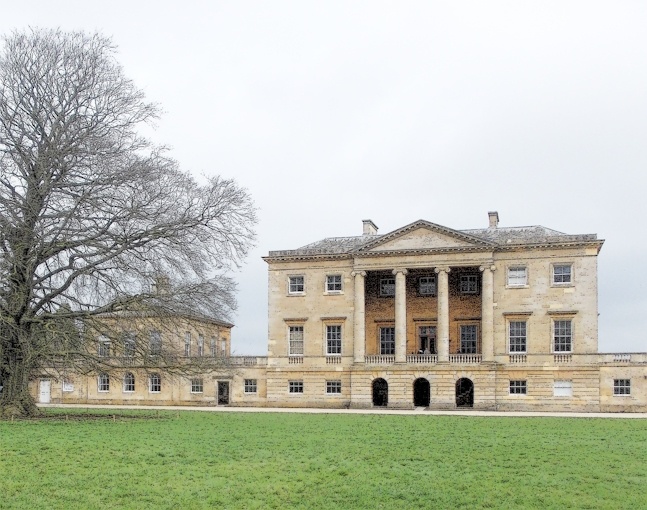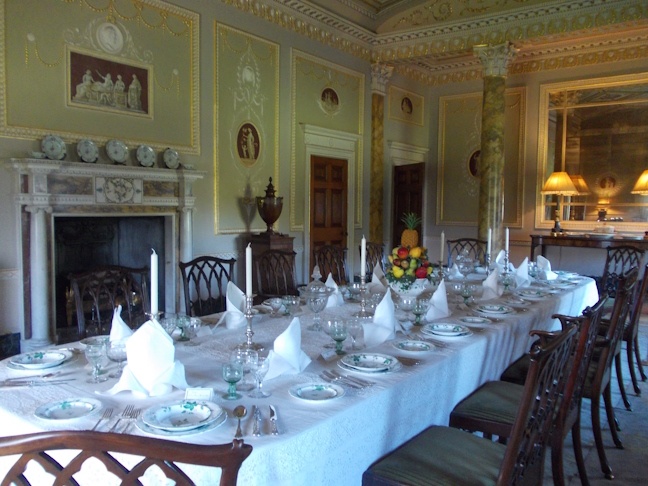
Basildon Park – Netherfield 2005
Sometimes the life of a house is as full of twists and turns as an angsty novel that follows a beleaguered heroine from riches to rags and back again. Basildon Park in Berkshire is a house with such an adventurous history.
An eminently Regency house, it was built in the late 1700s for Sir Francis Sykes, an East India Company nabob. It passed down to his son, who became notorious for his gambling and a very expensive court case for seducing the wife of a fellow officer. There was a duel too, but the second Sir Francis did not die on the field of honour. Instead, he was forced to flee his creditors and died of smallpox in Germany, leaving the much-encumbered estate to his eldest surviving son, another Francis, whose own extravagances eventually forced him to sell Basildon.
It was purchased by the Liberal MP James Morrison, one of the most successful merchants of his time. A self-made man, he made his vast fortune in haberdashery (among other things, he was astute enough to corner the market in black crêpe at the time of Queen Caroline’s death). He was also one of the first to see the benefit of the London commute. The main reason for purchasing Basildon was that the railway line was due to run past the very gates of the estate. Eventually it did, so thanks to Brunel’s engineering work and the steam carriages running at 50 mph he could dine at Basildon at seven and return to Paddington by midnight, ready for another day’s work. For all his humble origins, he was a man of excellent taste and a discerning art collector who filled Basildon with 17th century Dutch, Flemish and French masterpieces, as well as contemporary art.
The property did well in the hands of his son but not so much with subsequent inheritors. By the 20th century, the decline of Basildon had begun. It was in turn purchased for development, used as an army convalescent home in WWI and then requisitioned in WWII, when British and American troops practised tank warfare in the grounds and completed training for D-Day. Afterwards Basildon was used as a base for officers in charge of prisoners of war billeted in the huts in the woods, and then for housing the workers constructing a nuclear research facility nearby. By the time it was restored to its owner, it was in a sorry state.
To every fan of Pride & Prejudice 2005, Basildon Park is Netherfield, with its warm Bath stone glowing in the sunlight. With the sweeping approach and the gravelled drive where Mr Darcy helped Lizzy into the carriage, and then his fingers clenched and unclenched into that ever so adorable ‘O – M – G, I held her hand!’ Then there is the beautiful ballroom where they danced as though alone in the world. The room where Lizzy was shown in when she came to look after her sister. The octagon room, where Miss Bingley lorded it over everyone.
Downtown aficionados know it as the Grantham townhouse and if you’ve seen Pride and Prejudice and Zombies, you’ve been with Jane and Lizzy up on the roof. And in all those adaptations it’s impossible to imagine that there was a time when the lead was stripped off and sold, leaving the roof to decay and collapse into the hallway beneath. When every window in the house was broken. When a fire broke out in one of the upstairs rooms – then used as the officers’ mess – and destroyed both that room and the library below. When the doors, doorframes, chimneypieces and countless segments of cornice and plasterwork were dismantled and sold for parts.
Today, plasterwork decoration from the dining room can be found incorporated in the ceiling of the Basildon Room in the Waldorf-Astoria in New York. The rest of the house might have embarked on a similar journey in 1929, when George Ferdinando, the developer who owned Basildon for a while, undertook to “carefully take it down and re-erect it in America in any suitable position […], ready for occupation as a private residence, museum, college building or public library”, for the sum of $ 1,000,000. But those were the Depression years and Mr Ferdinando found no takers, so Basildon remained where it was, to be discovered and brought back to life by Lord and Lady Iliffe, who bought and restored it bit by bit in the 1950s to its full Georgian splendour.

Dining room, Basildon Park
It was an amazing labour of love, Lady Illife’s more than anyone’s. Tour guides tell heart-warming stories of Lady Iliffe climbing up to nail the felt on the walls of the octagon room, with no other help but the cook and the butler. Of how she and her husband salvaged doors, chimneypieces and all manner of other ornaments from country houses built by the same architect when, less fortunate than Basildon, those country houses were sadly demolished. How she tracked down the porcelain service commissioned by Sir Francis Sykes and brought it back to the house for which it was made. How she reunited the pier glasses in the octagon room with their tables, although they were sold to different people at different auctions. Or how, in later years, after the property was donated to the National Trust, she would remain deeply involved, come nearly every day to tell visitors about Basildon and often change the table arrangements or move items in the house, giving the stewards the fright of their lives when they thought that some precious vase or some other ornament had been stolen, because she had placed them in a different spot.
There are other stories, and you must come to hear them for yourself. Come in the summer, to see the rose garden at its best. And, fingers crossed, it won’t rain, and we might have a Regency picnic on the lawn.
Source: Basildon Park – The National Trust (2002)
Photos: Joana Starnes

8 comments
Skip to comment form
Alas I won’t get to see this in reality so I really appreciate your photos and information Joana. I love the line ‘come in the summer’ really this year that could be any time because we haven’t had any summer yet and the forecast doesn’t look brilliant so far. So, I think there maybe won’t be any picnics on the lawn, Regency or otherwise 😢. I’m hoping for better weather in August, it’s my twins birthday and they are having the party at home so fingers crossed they can let off steam in the garden for a while without having to erect a canopy and provide wellies 🤞🏻. Thanks again for travelling the country to provide me with details of these great houses. I’m sure that’s why you do it? 🤔😉.
What a beautiful ode to the house.
Thank you, Joana!
Lovely hearing the house’s story. I won’t get to tour it but nice to read about a lady who “cared” enough to restore it. Hope all is well with you. I had 101 degrees on my car’s windshield thermometer today. We have heat warnings daily.
Thank you, Joana. That house has an amazing story!
Thank you for sharing this story about an beautiful home. I think that the history not only had impact on the house but for the women and the staff who lived and worked for the house. The men, like younger men with nothing to to, made mistakes in their selfish disdain of the feelings for others. The people who visit this house, now in National Trust, can be happy to have the opportunity through the support and work of the Lord and Lady Iliffe.
We visited this beautiful house in March when it was quite cold and didn’t get the chance to explore the huge grounds because it was very windy and rainy.
Hopefully we will be returning in the next week or so and I can imagine that I am watching a scene with Mr Darcy and Elizabeth.
Thank you.
Ooh, I had no idea the house I saw in the films contained its own dramatic backstory! Thanks so much for sharing all of those details, Joana. I love how you so often give us a glimpse into the life behind the story!